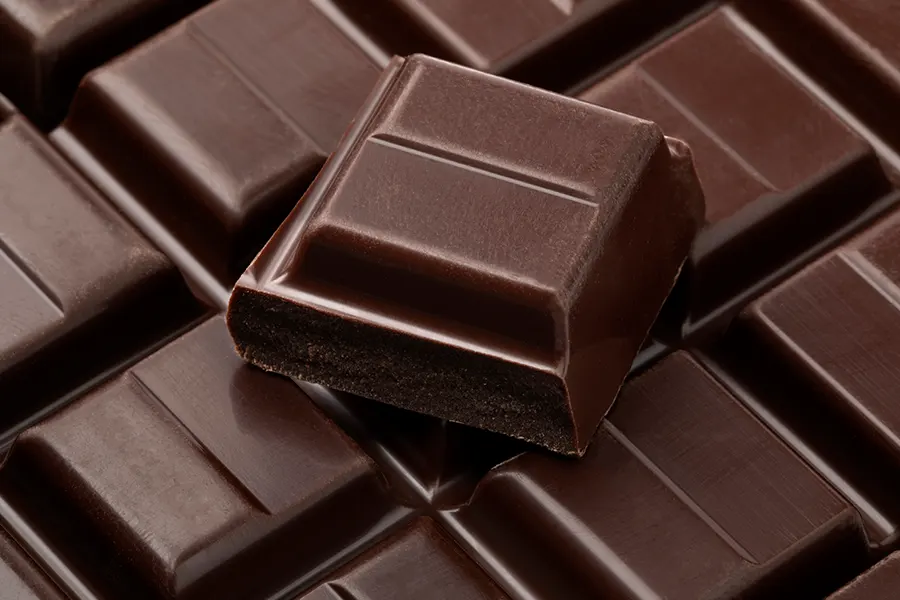Milk chocolate’s slightly more bitter cousin, dark chocolate, is a popular chocolate variety across the world. Millions of people consume and enjoy it regularly, and for good reason! It not only has some health benefits (which we’ll get into a bit later), but it is also well paired with different foods and drinks.
Of course, you can consume dark chocolate all on its own. It’s simply a matter of personal preference. But how much do you know about this delicious treat? In this article, we’ll cover all you need to know about dark chocolate. Let’s dive right in!
Ingredients
It’s a well-known fact that chocolate is made from cocoa beans, which are ground to various sizes to produce different textures. But what exactly are the dark chocolate ingredients? The answer is simple: dark chocolate can contain anywhere from 50% to 90% cocoa solids, which are combined with cocoa butter and sugar. No milk solids are added in the production process.
Varieties and flavors
We mentioned some numbers and percentages above and you may be wondering what this all means. In short, dark chocolate comes in different varieties. These varieties are subsequently distinguished by the percentage of cocoa solids in the bar itself. In fact, the varieties are generally placed on a scale, which means that dark chocolate can be classified as “sweet”, “semi-sweet”, or “bittersweet”.
And as for the question, what percent is dark chocolate, this will again depend on the type and variety you choose. Most commercial dark chocolate bars have around 30% cocoa content whereas the more bitter and darker versions can contain up to 80% cocoa content. As such, the higher the percentage of cocoa content, the more bitter it is.
Having covered the different varieties, you will already know that dark chocolate is more bitter than milk chocolate. So, answering the question “what does dark chocolate taste like?”, bitterness is one describing characteristic, whereas in terms of texture it is more chalky and less smooth and sweet than milk chocolate.
Production process
The dark chocolate production process is quite complex. It all begins with the cacao pod, which is a bit larger than the size of an average hand. From there, seeds or beans are extracted from the pod. These are then fermented, dried, and roasted to give us cocoa beans. But it’s not over, this is just the beginning!
Once we have cocoa beans ready, the shells and the meat of the bean are separated from the cocoa “meat” or “nibs”. Next, these nibs are ground into a liquid, which is often referred to as chocolate liqueur. Another separation process happens when the fatty portion of the meat is also separated. This fatty portion is actually the basis of cocoa butter.
Going back to the liqueur, there is a further process of refinement to give us the dark chocolate we know and love today. Meanwhile, after the nibs are removed, the cocoa bean is ground into powder, which can also be used in baking and in the preparation of beverages.
Health benefits
Although it suits a very particular palette, dark chocolate is not only for cooking, beverages, and unadulterated enjoyment. There are actually many health benefits associated with it – it is a source of iron, copper, magnesium, zinc, phosphorus, and antioxidants which are called flavonols. These flavonoids can offer several health benefits. Curious what they are?
Different studies and research have shown that dark chocolate consumption, in moderation, of course, has been linked to a reduction in free radicals, improvement in blood flow, lowering blood pressure, lowering “bad” cholesterol, reducing inflammation, reducing insulin resistance, improving the brain’s ability to make new connections between neurons, and increasing microbiome diversity, among others.
Ideal food pairings and different ways of consumption
Now that you know why dark chocolate is good for you, you may be wondering what to eat with dark chocolate. Of course, you can consume it just as it is out of the package without any prior preparation. However, it can also be used in multiple recipes.
Whether chopped, ground, shaved, or melted, it’s great for dishes like ganache, glazes, mousse, pudding, chocolate chip cookies, etc. It’s even useful in vegan recipes because it doesn’t contain milk.
Interesting facts
Cocoa consumption dates back to over 2000 years BC by the Maya from Central America. Known as the first connoisseurs of chocolate, they initially drank it as a beverage. This was actually fermented and mixed with either spices or wine.
Fast forward several thousand years later and we have the dark chocolate as we all know and love it. But did you also know that the mere smell of chocolate can increase the theta brain waves, which in turn, trigger relaxation?
What’s also interesting is that the higher the percentage of cocoa solids in dark chocolate, the higher the caffeine content.
Lastly, it can be stored unrefrigerated for anywhere between one and two years in a well-sealed container.
Where to buy dark chocolate
Your mouth is probably already watering by now, as simply mentioning dark chocolate makes you want to have some already. But don’t worry! There is a simple way to get possibly the best dark chocolate around.
Simply browse our extensive website where we showcase everything dark chocolate related that’s on offer, ranging from unique, fully custom chocolate gifts to unique chocolate gifts for any occasion.
And if you need any help, we’re just a click away! So, feel free to explore our delicious range of chocolate and choose your favorite.

